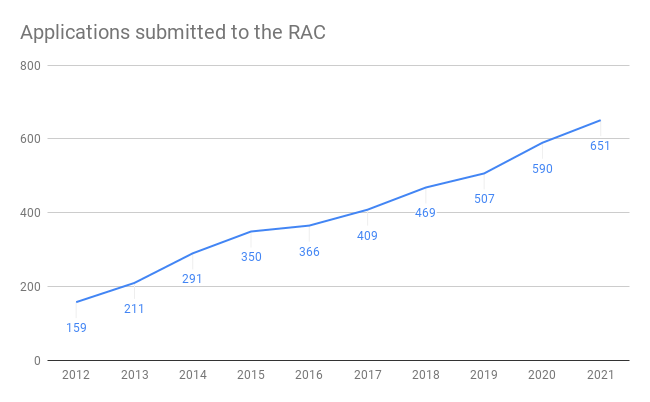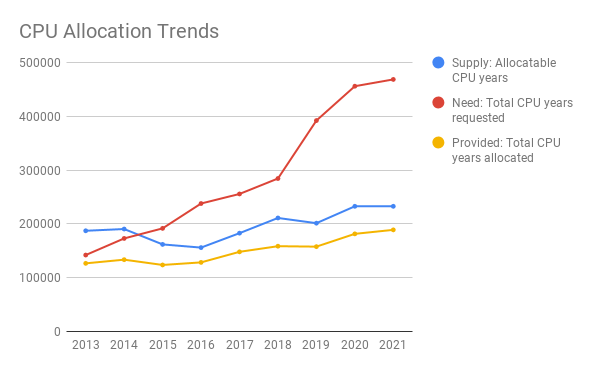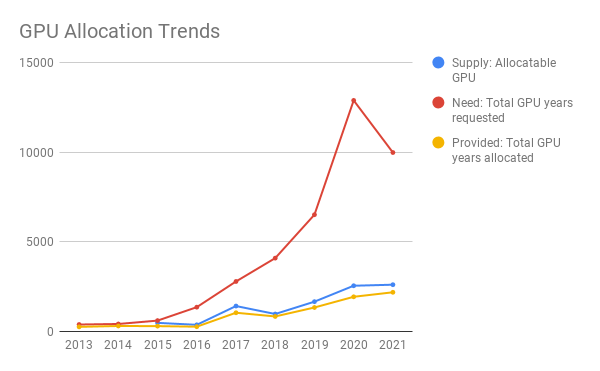Please find here the List of Resource Allocation Competitions 2021 Awards
Canada’s national advanced research computing (ARC) platform is delivered through the Compute Canada Federation (CCF), which is a partnership of Compute Canada, regional organizations (WestGrid, Compute Ontario, Calcul Québec and ACENET) and institutions across Canada. Providing researchers with access to the infrastructure and expertise they need to accomplish globally competitive, data-driven, transformative research, this national ARC platform serves the needs of more than 18,000 users, including over 4,850 faculty based at Canadian institutions as of January 1, 2021.
For RAC 2021, the national ARC platform provided approximately 233,000 CPU cores, 62,000 virtual CPUs, 2,610 GPUs and 150 PB of storage on Cedar (Simon Fraser University), Graham (University of Waterloo), Niagara (University of Toronto), Béluga (Calcul Québec) and Arbutus (University of Victoria).
Ongoing growth in researcher demand for resources means that demand continues to outstrip supply. The 2021 RAC competition received the highest number of applications in its history with 651 projects submitted — 10% more applications than 2020. This year’s RAC was only able to award 40% of the total compute requested, 90% of the total storage requested, and 22% of the total GPUs requested. This year’s RAC was able to allocate 100% of the total vCPUs (virtual CPUs) requested on the Arbutus, Béluga, Cedar and Graham clouds.
While close to 80% (on average) of the resources available are allocated through the RAC, the CCF reserves a target of 20% for researchers to use through the Rapid Access Service (RAS), which grants all users access to modest quantities of compute, storage and cloud resources as soon as they have a Compute Canada account.
If you have questions about the terminology used in this page, please consult the Technical Glossary. If you have any questions about the overall report, contact the RAC Team at [email protected].
Table 1: Applications submitted to the Resource Allocation Competitions
| Year | Applications submitted | Year-over- year increase |
| 2021 | 651 | 10% |
| 2020 | 590 | 16% |
| 2019 | 507 | 8% |
| 2018 | 469 | 15% |
| 2017 | 409 | 12% |
| 2016 | 366 | 5% |
| 2015 | 350 | 20% |
| 2014 | 291 | 38% |
| 2013 | 211 | 33% |

*Note: This report is based on the information available as of March 3, 2021
CPU Allocations
Based on available computing resources, RAC 2021 was able to meet 40% of all of the CPU (core year) requested — this is the same allocation rate as last year. Cedar, Graham, Niagara and Béluga provide 100% of the available capacity or approximately 233,000 cores, of which close to 80% are available for RAC allocations.
Table 2: 2021 Compute Allocations per System
| Allocatable Core Years (100% capacity) | Total CY requested | Total CY allocated | % of CPU capacity allocated | |
| Béluga | 28,000 | 54,339 | 22,692 | 81% |
| Cedar | 94,528 | 173,357 | 71,182 | 75% |
| Graham | 34,784 | 68,705 | 27,506 | 79% |
| Niagara | 75,840 | 172,097 | 67,546 | 89% |
| Total | 233,152 | 468,498 | 188,925 | 81% |
Table 3: Historical Compute Ask vs. Allocation
| Allocatable CPU CY | Total CY Requested | Total CY allocated | Difference | % of the demand awarded |
|
| 2021 | 232,704 | 468,498 | 188,925 | 279,573 | 40% |
| 2020 | 232,704 | 455,892 | 181,502 | 274,390 | 40% |
| 2019 | 201,320 | 390,352 | 157,262 | 233,089 | 40% |
| 2018 | 211,020 | 284,347 | 158,612 | 129,325 | 56% |
| 2017 | 182,760 | 255,638 | 148,100 | 107,538 | 58% |
| 2016 | 155,952 | 237,862 | 128,463 | 109,399 | 54% |
| 2015 | 161,888 | 191,690 | 123,699 | 67,991 | 65% |
| 2014 | 190,466 | 172,989 | 133,508 | 39,481 | 77% |
| 2013 | 187,227 | 142,106 | 126,677 | 15,429 | 89% |

Scaling CPU Requests
As described above, there were insufficient ARC resources to fully meet the CPU demand through RAC 2021.
As a result, a scaling function was applied to the 2021 competition to provide a means by which decisions on RAC allocations, in a context of insufficient capacity, could be made. This function, which is endorsed by the Chairs of the review committees, was set so that only applications with a science score of 3.0 or higher (out of 5) received an allocation. Applicants who did not receive a compute allocation can still make opportunistic use of system resources via the Rapid Access Service. The average score of all of the applications submitted to the RAC 2021 was 3.5.
CPU requests are scaled based on the overall score of the application and the size of the request. Details and examples of the scaling function are available here. For further questions, contact the RAC Team at [email protected].
Minimum size of RAC requests and opportunistic compute access
All researchers and their sponsored users with an active Compute Canada account can automatically make opportunistic use of CPU and GPU resources on any system. (This ability to compute without an allocation is also referred to as the Rapid Access Service). There is no guarantee on how much CPU or GPU can be consumed by non-RAC holders, as their use of the systems is purely opportunistic.
The RAC application process requires a minimum ask amount for compute resources (currently set at 50 core-years for CPU and 10 GPU-years for GPUs). These minimum values are set in part to control the number of applications requiring peer-review. As the number of applications increases every year, the workload of the expert review committees increases proportionally. Therefore, a RAC award made at the minimum level is and will ensure higher job priorities than for any non-RAC awardee.
While usage by non-RAC awardees is opportunistic, historical utilization data shows that many groups are able to reach (or even exceed) the RAC minimums specified above. Non-RAC users who want to maximize their compute usage need to consider strategies that ensure:
- they regularly have jobs in the queue;
- are able to tolerate longer wait times for jobs to start; and,
- submit jobs with “optimal” characteristics.
For example, opportunistic jobs with short time limits that request a few coreson a general purpose (GP) system will generally run much sooner than those requesting dozens of cores.
Please read this useful documentation about allocation scheduling priorities and job scheduling policies or contact us at [email protected] for advice on how to maximize usage for a non-RAC awardee.
GPU Allocations
The demand for GPU resources continues to be more competitive than for CPU resources. As Tables 4 and 5 show, requests for GPUs have increased almost 10 fold since 2016. Despite the decrease of ~23% in the amount of GPU resources requested compared to 2020, the allocation rate in 2021 was 22%.
GPU allocations are determined by the following factors: the overall score of the RAC application, the technical justification provided, evidence of previous GPU utilization, the research area of application for which GPUs are requested (e.g., Artificial Intelligence (AI), machine learning, etc.), and the size of the research group.
Keep in mind the following:
- In general, RAC applicants find it difficult to estimate their GPU needs, which in most cases are over requested (and underutilized). We strongly encourage future RAC applicants to do two things before applying: start using the GPUs in order to get a better understanding of their needs and consult with our technical staff. Our staff can provide advice on how to benchmark your codes and calculate your GPU needs as accurately as possible.
- GPU allocations are constrained, among other things, by the type of GPU (Pascal, Volta, T4) requested and available in each system.
- The demand for GPUs for AI applications has increased considerably.
Table 4: 2021 GPU Year Allocations per System
| Allocatable GPU Years (100% capacity) | Total GPU Years requested | Total GPU Years allocated | % of GPU capacity allocated | |
| Béluga | 688 | 2,408 | 570 | 83% |
| Cedar | 1,352 | 5,591 | 1,147 | 85% |
| Graham | 498 | 1,858 | 422 | 85% |
| Helios | 72 | 123 | 57 | 79% |
| Total | 2,610 | 9,980 | 2,196 | 84% |
Table 5: Historical GPU demand vs. supply (GPU years
| Allocatable GPU Years | GPU Years requested | Total GPU Years allocated | Difference | % of the GPU need awarded | |
| 2021 | 2,610 | 9,980 | 2,187 | 7,370 | 22% |
| 2020 | 2,552 | 12,885 | 1,936 | 11,165 | 15% |
| 2019 | 1,664 | 6,555 | 1,331 | 5,224 | 20% |
| 2018 | 976 | 4,092 | 840 | 3,252 | 20% |
| 2017 | 1,420 | 2,790 | 1,047 | 1,743 | 385% |
| 2016 | 373 | 1,357 | 269 | 1,088 | 20% |
| 2015 | 482 | 608 | 300 | 308 | 49% |
| 2014 | NA | 420 | 308 | 112 | 73% |
| 2013 | NA | 390 | 259 | 131 | 66% |

Cloud Allocations
The Arbutus cluster at the University of Victoria has 41,920 allocatable vCPUs (virtual CPUs). These are available via RAC and RAS and are also utilized for internal Compute Canada services such as software development and hosting. Relatively small cloud offerings are also implemented on Cedar, Graham and Béluga. For RAC 2021, the request for vCPUs overall increased by 65%: a 74% increase in compute vCPUs and a 20% increase in persistent vCPUs.
Overprovisioning of persistent vCPUs at a 10:1 ratio has allowed a significant expansion in persistent allocations in the previous few years. Even with the slightly reduced numbers this year, demand for real cores has continued to keep pace with hardware expansions with utilization numbers well over 80%, past which makes scheduling larger compute instances more difficult.
Between Arbutus and the additional nodes on Cedar, Graham, and Béluga, this year’s RAC was able to allocate 100% of the total virtual CPUs requested.
Storage Allocations
Storage integrated with Cedar, Graham, Arbutus, Niagara and Béluga provided approximately 151 PB of storage capacity for 2021. This meant that, across all types of storage, the CCF was able to allocate a total of 90% of its available storage capacity.
Table 6: 2021 Storage Need vs. Supply by Storage Type (TB)
| Category | Type | Supply (TB) | Storage requested (TB) | Storage allocated (TB) | % of the demand awarded |
| HPC | Project | 55,030 | 51,299 | 41,967 | 82% |
| HPC | Nearline | 67,800 | 61,101 | 58,201 | 95% |
| HPC | dCache | 14,105 | 13,001 | 13,001 | 100% |
| Cloud | Volumes and snapshot storage | 4,980 | 3,784 | 2,943 | 78% |
| Cloud | Object storage | 7,000 | 4,883 | 4,883 | 100% |
| Cloud | Shared cloud storage | 2,000 | 742 | 742 | 100% |
| Total | 150,915 | 134,810 | 121,737 | 90% |
We established our annual Resource Allocation Competitions (RAC) in response to the Canada Foundation for Innovation’s (CFI) requirement to award advanced research computing (ARC) resources based on the scientific merits of the research proposed. In addition to this requirement, we must evaluate the technical merits of allocation requests.
To meet these two requirements, RAC involves two review processes each year:
- a scientific review, which is a peer-review process involving more than 80 discipline-specific experts from Canadian academic institutions. These volunteers assess and rate the merits of the computational research projects submitted. The scientific review results in a single score that provides a critical and objective measure to guide allocation decisions; and
- a technical review that is undertaken by Compute Canada Federation (CCF) staff who are responsible for verifying the accuracy of the computational resources needed for each project based on the technical requirements outlined in the application and for making recommendations about the national system to which the resources should be allocated to meet the project’s needs.
The overall process is overseen by the RAC Administrative committee, which includes representatives from each of the national system host sites.
Note that while new applications receive both scientific and technical reviews, applications submitted via the Fast Track process and Research Platforms and Portals (RPP) with a multi-year award receive only a technical review.
Guiding Principles
RAC is guided by the following principles:
- all applications are given fair consideration through both a scientific and technical review process;
- resources are awarded based on the merits of the computational research project presented, rather than the merits of the overall research program;
- there is no direct correlation between the amount of computational resources needed and the quality (excellence) of the research outcomes of a project – important research can be done with a small amount of computational resources; and
- the challenges arising from the shortage of resources and other constraints within the system are shared among all applicants.
Technical Review
The technical review is conducted by technical experts of the Compute Canada Federation who:
- ensure the appropriate system is requested by the PI and the required software is available;
- evaluate application efficiency and scalability;
- identify groups that may need help with application and workflow optimization;
- identify discrepancies between the online request and the complete description of the project;
- identify special software requirements;
- provide a technical opinion on the reasonability of the request.
Technical reviewers are required to sign a Non-Disclosure Agreement prior to accessing any RAC application.
Science Review
New applications submitted to the RAC are peer-reviewed and scored. Scientific reviewers are required to sign a Non-Disclosure Agreement and accept the Conflict of Interest Policy prior to accessing any RAC application.
The final RAC score is based on the following:
- the scientific excellence of the specific research project for which computational resources are being requested;
- the scientific and technical feasibility of the proposed research project;
- the appropriateness of the resources requested to achieve the project’s objectives; and,
- the likelihood that the resources requested will be efficiently used.
Applications are reviewed in one of the committees below:
- Astronomy, Astrophysics and Cosmology
- Bioinformatics
- Chemistry, Biochemistry and Biophysics
- Computer Sciences and Mathematics
- Engineering
- Environmental and Earth Sciences
- Humanities and Social Sciences
- Nano, Materials and Condensed Matter
- Neurosciences, Medical Imaging and Medical Physics
- Subatomic Physics, Nuclear Physics and Space Physics
These values represent an average across the national ARC platform’s facilities and include total capital and operational costs incurred to deliver the resources and associated services. These are not commercial or market values. For the 2021 competition, the value of the resources allocated was calculated using the following rates:
Table 7: Financial Value of RAC Awards
| Resources | 2021 |
| 1 core year | $121.34 |
| 1 GPU year | $2,435.89 |
| 1 TB of project storage /year and dCache / year | $54.96 |
| 1 TB of nearline / year | $25.66 |
| 1 VCPU year | $80.93 |
| 1 TB of volume and snapshot storage (Ceph) / year | $117.70 |
| 1 TB of object storage | $49 |
| 1 TB of shared filesystem storage | $49 |